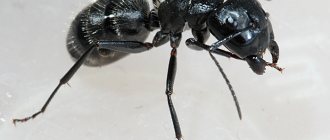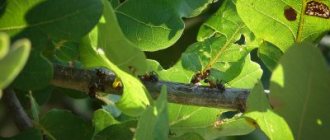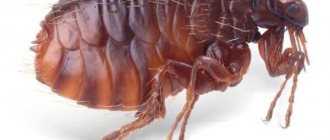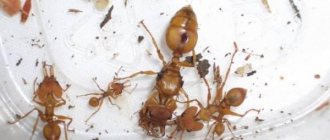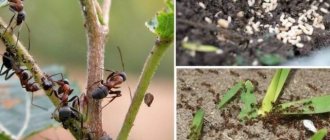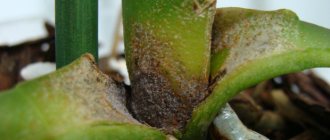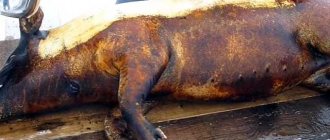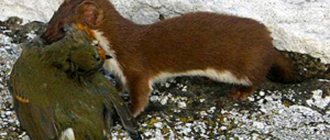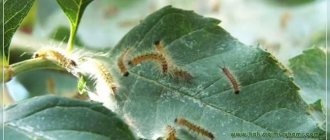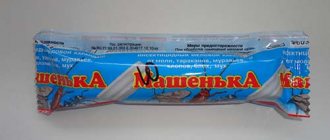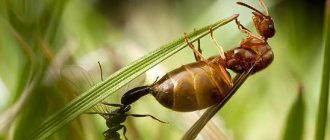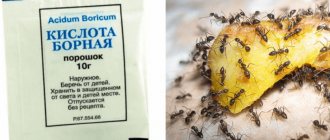All summer residents are very sensitive to their garden plants, protect and care for them. The plants, in turn, thank them with an excellent harvest. But sometimes it happens that a tree, shrub or vegetable crop becomes diseased, and in this case it is necessary to identify the problem as quickly as possible and begin to solve it. So if you notice that the leaves on the currant bushes have begun to shrink and curl, then most likely aphids have appeared on the back of the leaves, which means the ants are already located somewhere nearby, since these insects live in symbiosis and almost always act together. Further in the article we will look at: aphids and ants on currants.
Causes and consequences of ant attacks on currants
Currants give off a pleasant aroma that attracts almost all types of ants: meadow ants, black garden ants, red forest ants and the like.
Causes
The main reason why ants attack plants is aphids. Aphids have a partnership with ants, where the latter protect the former by fighting insects such as lacewings, ladybugs, ground beetles and others.
And the aphids, in turn, provide the ants with a constant supply of honeydew - this is the sweetish excess liquid secreted by them. Ants consider this liquid a very valuable resource. As a rule, ants build their anthill close to some vegetation.
Consequences
First of all, insects eat the roots of plants and fruit trees during the construction of an anthill, and then:
- They reduce the fruiting of plants by destroying the inflorescence by eating the nectar of flowers.
- During hot weather they eat the upper parts of young shoots of bushes.
- Insects colonize aphids on shrubs and trees.
- In order to get the necessary nutrients, ants attack red currants and other plants and drink all their liquid, which leads to the fact that the plant may not survive the winter.
To ensure that aphids and ants no longer appear on currants, you need to use various means to combat them.
What to do if you are bitten by an ant
And finally, let’s talk about what to do if, during a difficult struggle, several small goosebumps feel free to “nip” your hand or another part of the body.
A slight itching caused by a single bite goes away after a few hours and does not pose a danger to humans.
It is much worse if an allergic reaction develops, the signs of which are the following symptoms:
- the appearance of swelling, blisters, itching;
- extensive redness of the skin, accompanied by pain;
- nausea, shortness of breath, headache, loss of consciousness.
Treatment for ant bites is as follows:
- wipe the bite site with a medicine containing alcohol;
- make a baking soda compress to relieve itching;
- relieve swelling that occurs after several bites using a compress of steamed birch leaves or raw potato pulp;
- take antihistamines;
- In case of severe damage, consult a doctor.
As you can see, it is quite possible to completely get rid of ants. Do this without any regret, because real pests settle on your site, which, unlike their forest counterparts, are not beneficial insects, but only cause harm to your plantings and food supplies.
Beneficial effect on shrubs
Many people know from school that anthills should not be broken. This comes from the fact that even ants that are not loved by everyone can also bring benefits, namely:
- Destroy caterpillars and harmful insects.
- During the construction of their anthill, they loosen the top layer of soil and also fertilize it with potassium, nitrogen and humus.
- They collect corpses throughout the garden and speed up the process of their decomposition.
Ants: benefit or harm
Benefit
Ants on strawberries - how to get rid of them
Ants destroy harmful insects by eating their larvae. By establishing their settlements in the fertile layer, they help plants receive more air, which, in turn, grow better and produce crops. Also, nutrition is better supplied to the roots in such soil, which naturally affects the quality and quantity of the harvest.
Harm
Aphid
The most dangerous thing is that when ants appear on the site, they bring with them their “pets” - aphids. She feeds on plant sap. If you do not react in a timely manner, this can lead to withering and then to the death of the plantings.
How to deal with the invasion?
There are many ways in which you can protect currants from aphids and ants:
- strong odors;
- traps and baits;
- barrier;
- professional products;
- destruction of the anthill;
- colony transfer;
- destruction of aphids.
Strong odors
Like most insects, ants do not like plants that emit a strong odor. Although they do not cause them any harm, insects still try to avoid plants such as:
- nasturtium;
- rosemary;
- marigold;
- catnip;
- dill;
- parsley;
- lavender;
- peppermint;
- Melissa;
- fennel and other aromatic herbs.
Ants are afraid of these plants not only because of the strong smell, but because they attract insects that aphids are so afraid of. Therefore, pests will not be able to establish a colony near these plants and they will have to do this in another place in order to get a sufficient amount of sweet honeydew.
It would not be a bad idea to make a strong decoction of green plants and sprinkle it on the places where clusters of ants live. It will repel them, but the smell won't last long. This means that you will have to periodically spray the accumulation area.
Traps and bait
Garlic infusion
If you have little time, you can simply cut the cloves of garlic and place them near the anthill, but this is ineffective. Garlic will bring more benefits if it is grated and mixed with sawdust. And place the resulting composition near the anthill.
And if you have more time, you can prepare a garlic tincture, which can remove most of the pests. To do this you need:
- Chop 1 head of garlic.
- Fill it with water.
- Leave to infuse for about 24 hours.
- Pour the resulting tincture over the anthill.
Jam with boric acid
Boric acid was used long before people invented the various pest control chemicals that now fill store shelves. Despite the old age of this method, it still remains relevant, and a large number of people successfully expel harmful insects from their gardens.
Boric acid is tasteless and odorless. It appears to be a white powder consisting of small crystals. 100 years ago it was used to treat certain diseases and old wounds.
And for insects, boric acid is a means that can kill them. To save currants from various types of aphids and ants, a microscopic drop of acid is enough. And also if the relatives of an insect that died from acid eat its corpse, then they too will share its fate.
If you add boric acid to some tasty treat, the insect will not die immediately, but will return to the anthill with a belly full of poison.
Caution: Boric acid will not cause much harm to humans, but you should still be careful when preparing the trap.
How to use boric acid correctly:
- Mix 5 grams of boric acid with jam (or other sweets) and add a few drops of cold water.
- Stir until the mixture becomes liquid.
- Everything that turns out will need to be placed on paper folded several times or a small plastic cover and placed near the anthill or where ants most often appear.
Jam with added yeast
When an ant eats yeast, a fermentation reaction occurs right in its stomach. First, bloating and increased gas formation occur. This situation is especially dangerous for small insects, as they are simply torn apart.
And since ants are social creatures, they will not eat the food they find alone, but will take it to their anthill, and thus almost the entire colony will die out.
Making this remedy is very simple, you just need to mix the jam with yeast, and then place the mixture in a suitable container and place it near the anthill.
Important! In the garden, this method should be used only when absolutely necessary, as this may cause harm to other insects beneficial to the garden.
Ammonia
Ammonia has a specific smell of ammonia, which insects strongly dislike. In order to get rid of pests using this method, you need to mix 2 tablespoons of the product with 5 liters of water. Fill the anthill and ant paths with the resulting solution.
Barrier
Often, in order to protect fertile trees, hunting belts such as “Inta-Vir” or “Kapkan” are used. Thanks to these traps, the ants stick their paws to them and die.
But you can also make barriers with your own hands:
- A piece of aluminum foil is rolled around a tree trunk, with the bottom edge at an angle, and to prevent the barrier from creasing, you can put a strip of foam rubber under the foil.
- Cut a piece of sheepskin into long and narrow strips, then soak them in carbolic acid and wrap them around a tree trunk.
If there is a need for this, you can sprinkle one of the ant trails:
- ground pepper;
- mustard powder;
- fine wood ash;
- lime.
The ants will suffocate as they crawl through this path. After some time, the ants will stop walking along this path.
The disadvantage of this method is that such protection will be washed off after the first rain.
Preventive measures
Prevention of the appearance of aphids on currants should begin in the fall, after all the leaves have fallen from the bush. The litter should be removed and burned, and the shoots should be treated with special means to destroy pest eggs, such as Nitrafen
Particular attention should be paid to damaged bark and areas with kidneys
In early spring, it is better to mulch the ground around the bush
It is important to remove weeds on time. The following should not be planted near currant plantings:
- mint;
- sage;
- thyme;
- lavender;
- oregano;
- clean.
Gall aphids migrate to them in mid-summer, when the currant leaves become too hard. These crops are suitable for further reproduction of the pest - a generation of heterosexual individuals appears on them, which return to the currant bushes and lay eggs.
Chamomile, marigold and calendula repel pests with a specific smell. They can be planted between rows.
For maximum protection of currants from aphids, it is important to combine methods of control and prevention, as well as monitor plants located near the bush. The spring period is especially important, when aphid colonies just appear, and chemical treatment is possible
Using professional products
Before you start using professional means to get rid of insects, you must first try to get rid of ants on currants using folk remedies, since specialized preparations also kill beneficial insects, which, in turn, get rid of other pests.
Clean house
Clean Home is an inexpensive gel that works well against pests that will attack not only at home, but also in the garden.
You can apply the gel either on ant paths, or first apply it in a dotted manner on paper, and then place it in a place where ants accumulate. The poison will begin to act in 24-36 hours.
The advantages of the gel include its ease of use and availability, while the disadvantages include long periods of action, which amount to 3-4 weeks.
Important: The gel is harmful to humans and pets, so before use you need to make sure that no one is poisoned by it.
Summer resident
The Dachnik preparation is based on fir oil, which repels garden ants and other pests.
The advantages of this drug include:
- Easy to prepare.
- Economical.
- Efficiency.
- Wide range of applicability.
How to use:
- Shake and open.
- Pour 5 ml of the drug into an 8-liter bucket filled with water and mix with a stick.
- After removing the top layer of soil from the anthill, water it with 2-3 liters of solution.
The protection will be valid for six months. In addition to the anthill, the product can also be used on beds and paths in the proportion of 5 liters per 1 cubic meter.
Grom-2
Grom-2 is a granule designed to get rid of pests such as soil flies and garden ants. For the drug to start working, you just need to spread it over the surface of the anthill so that the insects can come into contact with it. The drug is valid for 2-3 months. It must be applied with rubber gloves; although it is not harmful to plants and soil, the same cannot be said about human skin.
Thunder-2 from ants: instructions for use and principle of operation, read more in this article.
Phenaxin
This product is intended not only for treating premises, but also for vegetable gardens. It causes insects to curl up and not die immediately. First, on their paws, they carry the poison to their anthill, where they infect their relatives with it.
How to use:
Sprinkle a thin layer of powder onto the ant paths. If necessary, you can apply the powder again after a month.
Important! When using the drug, you need to make sure that the powder does not get on the plants. Phenaxin is safe for people and pets, but you still need to wear gloves when using the drug and keep your pets out of the garden for 1 month.
Muratox
Muratox gets rid of not only ants, but also fleas, larvae and basement mosquitoes.
How to use:
- Dilute 1-2 ml of the drug in 10 liters of water.
- Dig up the anthill and water it with freshly diluted solution.
- Sprinkle with earth.
Or you can lure the insects with some sweetness and spray them with the solution. Valid for 1 month. Muratox is dangerous for fish, so you should avoid possible contact of the solution with the water.
Ant-eater
One ampoule of anteater is diluted in 10 liters of water, and then you will need to water the anthill with the resulting solution. The drug will begin to act in 2-3 weeks.
Read more about how to properly use Anteater against ants in this article.
Pyrethrum
Pyrethrum is an insect repellent powder that is almost completely natural and very effective.
To prepare the infusion you need:
- Mix 300 grams of powder with 1 liter of water and let the solution brew for 12 hours.
- Do the same, but with 4-6 liters of water.
- Then mix solutions 1 and 2.
Use the resulting mixture to spray plants. All manipulations with the solution must be done with rubber gloves.
Antiant
This product has a filler that attracts ants, and it also does not have an unpleasant odor. It is necessary to evenly distribute the product along ant paths and their clusters. The ants will disappear in 2 days. The duration of action of the solution is almost 50 days.
What to do if you are bitten by an ant
And finally, let’s talk about what to do if, during a difficult struggle, several small goosebumps feel free to “nip” your hand or another part of the body. In temperate latitudes, an ant bite is not dangerous, but can be quite painful. Humans are usually bitten by warrior ants with large heads and powerful jaws.
A slight itching caused by a single bite goes away after a few hours and does not pose a danger to humans. It is much worse if an allergic reaction develops, the signs of which are the following symptoms:
- the appearance of swelling, blisters, itching;
- extensive redness of the skin, accompanied by pain;
- nausea, shortness of breath, headache, loss of consciousness.
The bite of one soldier ant is not scary for residents of the middle zone
Treatment for ant bites is as follows:
- wipe the bite site with a medicine containing alcohol;
- make a baking soda compress to relieve itching;
- relieve swelling that occurs after several bites using a compress of steamed birch leaves or raw potato pulp;
- take antihistamines;
- In case of severe damage, consult a doctor.
As you can see, it is quite possible to completely get rid of ants. Do this without any regret, because real pests settle on your site, which, unlike their forest counterparts, are not beneficial insects, but only cause harm to your plantings and food supplies.
How to destroy an anthill
Boiling water
First you need to dig out the anthill, and then fill it with hot water from the kettle, trying to keep a distance from other plants. This method does not guarantee 100% pest control.
Kerosene
- Dilute 150 ml of kerosene with 10 liters of water.
- Rake up the anthill and use a shovel to make a couple of holes in the top of the anthill.
- Pour the prepared solution into the anthill and cover it with polyethylene so that the smell does not disappear quickly.
After some time, the ants will change their place of residence.
Strong infusion of tomato tops
Since ants cannot tolerate strong aromas, you can scare them away by placing tomato tops on the anthill.
Hot ash
In order to destroy an anthill, first you need to stir it up, then pour the ash remaining after burning the grass, leaves, and branches while still hot into the ants' holes. This method will cause a lot of problems for insects and kill their embryos.
Vegetable oil solution
To prepare this product, you need to mix 10 liters of water with 400 ml of vegetable oil, vinegar and the same amount of shampoo. Then pour the resulting solution into the anthill, first making several holes in it, and then cover it with polyethylene. After 2-3 days the ants will disappear.
Traditional methods - what can you spray with during flowering and save the plant?
Environmentally friendly: do not kill ladybugs and bees. The following methods are good against ants:
- Scald with boiling water (first stir up the anthills; repeat the procedure several times; do not use near currants, so as not to destroy their roots).
- Water the anthills with a solution of kerosene and diesel fuel (measure 10 tablespoons of each substance, dilute in water (10 l)), place it near a container with oleic acid, the smell of which ants are “afraid of.”
- Place poisoned baits for insects (containers with a mixture of equal parts of boric acid and honey (sugar, jam or yeast) under the plants: such “feeders” are safe for people and animals; boric acid has a nerve-paralytic effect on ants; yeast spoils their food supplies , “intoxicate” the insects, and they stop obtaining food for their queens and larvae).
- Sprinkle anthills and bushes with lime, wood ash, tobacco dust, red pepper or cinnamon.
Currants can be sprayed against aphids with herbal decoctions and infusions:
- Garlic - half a kilogram of raw material is infused in five liters of water at room temperature for one day; sprinkle with strained garlic water.
- Tomato leaves - chop fresh tops (4 kg) and dry tops (2 kg), boil in water (10 l) for half an hour, cool, strain; store in a cool place, apply by diluting the decoction in a ratio of 1:5.
- Wormwood and ash - mix 500 g of herb, 5 liters of water and a glass of ash, leave for 5 hours; Before use, dilute with water 1:2.
- Also celandine, potato tops, dandelion and onion; mustard is also suitable for these purposes, but it is a strong allergen.
Aphids are also eliminated by fumigating bushes with celandine smoke and treating them with laundry soap.
Chemicals
Muratox
Dilute 1 gram of muratox with 10 liters of water and pour the solution into the anthill, and after 3 days the pests will disappear.
Muratsid
Also dilute 1 gram of the product with 10 liters of water and pour it into the anthill. The pests will disappear in 1 day.
Biorin
Dilute 2.5 ml of the drug with 1 liter of water and spray the anthill with the resulting solution. All ants will stop appearing after 1 day.
Sinuzan
Dilute 1 liter of water with 2.5 ml of product and spray the ant paths and the anthill itself.
Currant leafroller
Although this butterfly is called currant, with equal success it damages the leaves of other crops - both garden fruits and berries, and wild ones.
An adult insect is a butterfly with a yellowish-brown wingspan with dark spots up to 2.5 cm, males are smaller and lighter than females. The larvae of the first and second generations are brown-green with a black head, the next generations are yellow-green with a light abdomen and a brown head, reaching a size of 2 cm.
The flight of the first generation butterflies is observed approximately two weeks after the end of flowering of the apple tree and lasts 3–4 weeks. One female lays up to 200 yellowish-green eggs in 2–4 clutches “in batches” on the upper part of the leaf blade.
The first generation larva skeletonizes the leaf blades and damages the fruits, gnawing out individual holes in them, covered by a leaf attached to the fruit with a silk web, and causing them to rot. When they reach the third instar, most of the caterpillars go to winter - they can be found in dense silky cocoons in the forks of branches, at the base of the buds, under bark scales and dry leaves, attached by cobwebs to the branches. The remaining caterpillars continue to feed and pupate, subsequently turning into second-generation butterflies.
The second generation caterpillars go to winter at the end of September. The larvae emerge from wintering at the end of April, when the buds begin to bloom. At this time, they feed on young leaves, buds and flowers, while loosely entwining them with cobwebs and pulling them into clumps. They also damage fruit ovaries by gnawing holes in them.
Due to the presence of two generations and the length of summer, adult butterflies of this species are found almost throughout the entire summer period.
In addition to the currant budworm, currants with similar symptoms are also affected by the grape and bunch budrollers.
Transferring an ant colony
Ant colonies often consist of several nests connected to each other like a net. For this reason, you will have to move not only the main anthill, but also the nearest ones.
The new place for the colony should be similar to the previous one, and there should be no other anthills of the same species near it. Also, the distance between the previous place and the proposed one should not be more than a few hundred meters.
It is best to dig an anthill at sunset, when all the ants are in their nest. You need to move the entire nest, both its upper and lower parts. Large bags and buckets can be used for transportation. Usually the anthill goes 50 cm deep into the ground, but this distance can reach up to 2 meters.
The anthill does not need to be completely buried in a new place; the upper part should not be covered with earth. If the ants suddenly don’t like the place, they will move it to the right place.
Important: It is advisable to move the anthill in the summer so that the insects have time to prepare for the cold.
Signs of defeat
Types of insects that harm currants:
- The brown ant is a brown insect up to 9 mm in size. Builds dwellings that go deep into the ground. The above-ground part consists of plant residues. The pest eats flowers and currant berries, reducing productivity, and spreading aphids.
- The black garden ant is a representative of arthropods measuring 3-4 mm, with black outer integuments covered with short hairs. It builds a dwelling in the ground, creating numerous colonies, and breeds aphids.
- The sod ant is an insect up to 5 mm in size, yellowish-brown in color, that builds anthills underground. It feeds on currant berries.
Having noticed any type of pests on the site, you need to find their habitats. Anthills, established by insects in the garden, are holes in the ground with a characteristic sandy mound. By digging up an earthen mound with a shovel, you can find numerous passages; at the depths there are insect larvae and a queen. As the colony grows, the underground part of the dwelling grows in breadth and depth. Sometimes insects build anthills in the center of the currant root system.
Signs of a bush being damaged by a pest:
- stunting, lack of young growth;
- yellowing of foliage caused by malnutrition as a result of damage to the root system and increased soil acidity;
- buds and flowers with damaged petals;
- incompletely tied brushes;
- ugly berries;
- partially eaten berries.
The appearance of a sticky coating on the inside of currant leaves indicates that the bush is infested with aphids. At the same time as the pest, ants are found on the currants.
Destruction of aphids
Aphids are one of the most dangerous pests in the garden. The aphid is very tenacious and prolific; it attacks a large number of garden and garden crops.
Wood ash infusion
Some gardeners use wood ash as a fertilizer, but it can also be used as a remedy against aphids and as a preventive measure for plant diseases.
How to cook:
- Pour boiling water over 300 grams of sifted ash.
- Boil for half an hour.
- Sift, sift and dilute with water to a 10-liter volume.
- Then add 50 grams of soap.
Treat currants with the solution in the evening in dry weather to prevent ants and aphids.
Biological drugs
It is much more effective to use special biological preparations against aphids. Some of the most common are:
Aktara
250 ml of the drug should be dissolved in 1 liter of water, then shake well and start spraying the currants. The solution cannot be stored in this condition.
The insects will die in a day, and the protective effect will last for 2-3 weeks.
Karbofos
Dilute 1 packet per 8 liters of water; spend no more than 1.5 liters of solution per bush. The protection period is 1 month.
Rovikurt
Dissolve 10 grams of a 25% preparation in 10 liters of water and spray the currant bushes with the resulting solution. The protection period is 15 days.
Inta-Vir
You need to mix 1 tablet of the drug with 10 liters of water and spray the currants before flowering and after harvesting. You need to know when to stop and do not spend more than 2 liters of solution on 1 currant bush. The protection period lasts 2 weeks.
Do not spray the plant at the beginning of flowering.
Agrotechnical measures
It may be a little unusual, but the number of colonies will decrease significantly if you kill the aphids. By the way, you don’t need to completely get rid of ants. New, more adapted pests will take their place. Aphids are the main “herd” that supplies “sweet milk” - honeydew to the voracious ant larvae.
The duration of maturation of the egg lasts 35 days, larvae - 7 days and pupae - 23 days. The lifespan of the larvae is 7 days and they enter the pupal stage, which stops eating.
These 7 days are the weakest link of the ant colony. They intensively supply food to the larvae. If you feed the larvae poisoned food during this period, the colony may not be revived.
So, to successfully remove ants from a site, you can perform the following procedures with large colonies:
Around the bushes, stepping back from the base, sprinkle ash thickly in a ring, you can mix it with lime. Lime is poisonous to ants.
Approximately in the middle of the trunk (40-80 cm), secure the fishing belts, treating them with insecticidal agents. To prevent ants from crawling over the barrier, lubricate the bole around the perimeter with special slow-drying glue (buy in a store).
They will not be able to overcome the adhesive barrier and will die along with their expensive burden. Hunting belts can also be used in the spring and summer (October and March), periodically replacing them with fresh ones.
Simultaneously with the hunting belts, for 8 days in a row, having dug up the ant colony to a depth of 3-8 cm, poison them in the evening (when the ants return home), pouring hot boiling water over the stirred up anthills, preferably a hot decoction of tomato tops (literally boiling).
You can dig it up and fill it with a mixture of ash and lime or ash and salt, or treat it with a mixture of ash and soda.
A good result is obtained if you fill the anthill with a mixture of water and kerosene (100-200 ml per 10 liters of water), digging it deeper.
Daily treatment for 8 days will destroy the larvae, some adult ants, possibly the “queen,” eggs, and pupae. Such treatments must be carried out systematically throughout the year, and the ants will leave the inhospitable dacha.
Ants love peace and settle in places where the soil is not subject to frequent turning, that is, it is not dug up, stones, weeds, etc. are not removed. If you are farming without digging, then surface treatment of the top 10 cm of soil is required. Look under a stone or cardboard or board that has been lying there for a long time and you will see a bunch of ant eggs with nannies right on the surface of the earth.
Plantings around the perimeter of the dacha, individual beds, under the canopy of trees and, especially, between berry bushes of tansy, parsley, mint, valerian, wormwood, lavender, and garlic can serve as preventive preventative measures against the colonization of ants.
Prevention of occurrence
To ensure that aphids almost never appear, you need to constantly monitor the health of the plants.
You also need:
- Clear the garden of leaves.
- Mow down the weeds.
- Cut out root shoots and tops on which eggs can overwinter.
- Destroy or contain anthills in spring and summer.
Common Mistakes
Mistakes of those gardeners who decided to deal with aphids:
- they plant garlic thickly;
- After collecting garlic seeds, you must dry and check them, and then repeat the process before planting;
- infusions and decoctions are ineffective over large areas; in this case, you can use chemicals;
- After processing the trees, you still need to cut off the tops;
- If wounds are found on trees, you need to cover them with varnish and then spray it with copper-containing preparations. Otherwise, the tree may get sick.
It is very difficult to remove aphids and ants, but if you want to get results, then you don’t need to focus only on poisons. You need to constantly monitor your garden, every tree and plant. And only then can you get a good effect.
Folk recipes
Methods for controlling ants and aphids on currants must be effective and safe.
Initially, you should try to find an anthill. It is located deep underground, holes and passages are visible on the surface, and there is loosened soil.
There are several ways to remove an ant family from a site:
- fill the anthill with a bucket of boiled water;
- dig up the nest to the depth of a shovel;
- spray with boric acid solution;
- place the herring head on the anthill;
- sprinkle the nest with cinnamon;
- sprinkle with baking soda;
- pour gasoline on it and set it on fire.
Other methods of control involve expelling ants from the garden plot:
- The easiest way to get rid of aphids and ants using folk remedies is to plant garlic in close proximity. You can even use currants. If you didn’t have time to do this, lay out the garlic cloves, tie the shoots to the stems, and rub the branches.
- A sheepskin soaked in a phenol solution is tied to black currants. In the absence of wool, they use cotton wool, pieces of fabric, and clothesline. The smell of acid repels ants and allows you to save currants.
- Cinnamon and corn flour will help remove ants. They scatter the funds under the bush. Cinnamon scares away with a strong smell, makes you run wherever your eyes look. The second swells the stomach, the insects die.
- You can spray currants against aphids with a soda solution. Add a little linseed oil or liquid soap to the water. These substances allow the soda to remain on the leaves for a long time.
- Add yeast to the jam and place the bait under a bush. The ants eagerly eat the food, get drunk, and forget about their main responsibilities - they do not bring food to the anthill. This behavior of working individuals for a long time dooms the entire family to starvation.
- On currant bushes, attach sprigs of wormwood, tansy, elderberry, mint, and tomato tops.
Traditional methods show great effectiveness when the soil is slightly infested with ants. What to do if the colony multiplies, the remedies do not help, there is also an answer.
